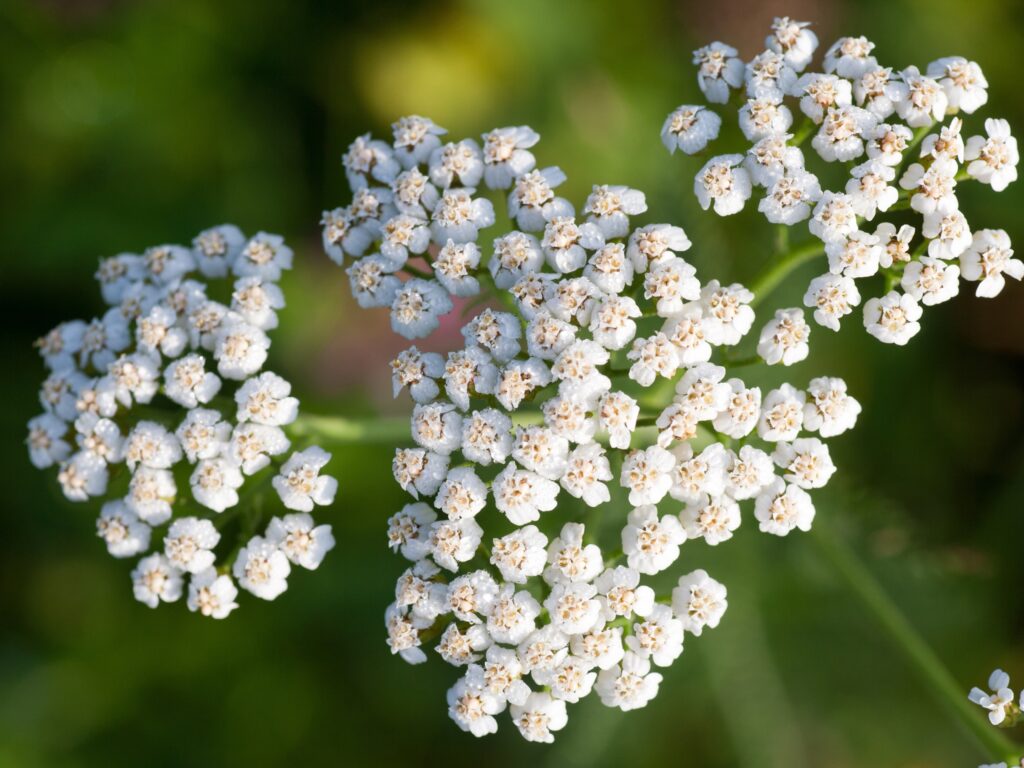Table of Contents
ToggleCommon Yarrow (Achillea millefolium): Nature’s Ancient Healer Making a Modern Comeback
In the ever-evolving world of natural medicine, Common Yarrow has stood the test of time. With its delicate white flowers and fern-like leaves, this resilient herb has been revered since ancient times for its healing properties. Now, thanks to renewed scientific interest and recognition as the Medicinal Plant of the Year 2025 by the University of Münster, yarrow is enjoying a well-deserved resurgence in the world of herbal wellness.
Let’s explore why Common Yarrow (Achillea millefolium) is still one of nature’s most potent and versatile remedies — and how you can safely use it to support your health today.
Botanical Profile: The Herb That Travels
Through Time
Scientific Name: Achillea millefolium
Family: Asteraceae
Also Known As: Soldier’s Woundwort, Nosebleed Plant, Thousand-Leaf
Native To: Europe and Asia (now naturalized globally)
This hardy perennial plant, commonly found in meadows, roadsides, and wild fields, has a long-standing reputation as both a spiritual and medicinal ally.
Historical Use: From Battlefields to Teacups
Yarrow’s rich medicinal legacy stretches all the way back to ancient Greece, where Achilles himself supposedly used it to treat his soldiers’ wounds — hence the genus name Achillea. But its use wasn’t limited to mythology.
Throughout centuries, Native American tribes, Celtic healers, and European folk practitioners used yarrow for:
- Stopping bleeding
- Easing stomach ailments
- Treating infections and fever
- Spiritual protection rituals
It’s not just folklore — modern studies are increasingly supporting these traditional uses.
Medicinal Uses: Nature’s Multi-Tasking Remedy
Common Yarrow owes its powerful effects to a rich combination of essential oils, flavonoids, alkaloids, tannins, and sesquiterpene lactones. These plant compounds make it one of the most versatile herbs in natural medicine.
- Wound Healing and Antiseptic Action
- Yarrow acts as a natural styptic, stopping bleeding quickly.
- Its astringent and antibacterial properties protect wounds from infection.
- Fresh leaves have historically been crushed and applied directly to cuts, giving it the nickname “Soldier’s Woundwort.”
- Anti-Inflammatory Relief
- Powerful flavonoids and lactones calm inflammation.
- Useful for soothing arthritic joints, sore muscles, and irritated skin.
- Digestive Aid
- Stimulates bile production and gastric juices.
- Effective in relieving bloating, cramping, gas, and indigestion.
- Often consumed as tea before or after meals for smoother digestion.
- Menstrual Support
- Yarrow acts as a uterine tonic, balancing menstrual cycles.
- Known to ease PMS symptoms, reduce cramps, and help regulate heavy flow.
- Can be taken as tea or tincture leading up to and during menstruation.
- Fever Reduction
- A natural diaphoretic, it encourages sweating and helps break fevers.
- Popular in herbal flu blends and teas during seasonal colds.
How to Use Common Yarrow Safely and Effectively
There are several traditional and modern ways to incorporate yarrow into your wellness routine:
Yarrow Tea
- Use dried flowers and leaves.
- Steep 1 tsp in hot water for 10 minutes.
- Drink up to 3 times a day for fever, digestion, or menstrual discomfort.
Tinctures & Extracts
- Available in health stores for more concentrated, faster-acting results.
- Follow the dosage on the bottle or as advised by a practitioner.
Poultices
- Crush fresh yarrow leaves and apply directly to cuts, insect bites, or bruises.
- Wrap with gauze for sustained contact.
Essential Oil
- Dilute and apply topically for muscle pain, inflammation, or aromatherapy.
- Not for internal use unless formulated for such.
Precautions You Should Know
Common Yarrow is generally safe for most people, but a few cautions apply:
- Allergic Reactions: Avoid if you’re allergic to ragweed or other Asteraceae family plants.
- Pregnancy Warning: Not recommended during pregnancy due to potential uterine-stimulating effects.
- Blood Thinners: Yarrow may increase bleeding risk, so avoid if on anticoagulants.
- Always consult your healthcare provider, especially if you’re taking other medications.
Common Yarrow Sustainability and Cultivation: A Gardener’s Dream
Yarrow isn’t just good for you — it’s good for the planet.
- Grows easily in poor soil, dry climates, and full sun.
- Attracts pollinators like bees and butterflies.
- Makes a beautiful, drought-resistant addition to herb gardens.
- Helps support biodiversity and soil health.
With minimal effort, you can grow this powerhouse plant at home and have access to fresh herbal support year-round.
Final Thoughts: Common Yarrow’s Modern Revival
Achillea millefolium, once a battlefield herb, is now reclaiming its role in modern health. Whether you’re reaching for a cup of yarrow tea during a cold or applying a fresh poultice to a scrape, this resilient wildflower offers more than just beauty — it offers healing.
Now backed by modern research and centuries of traditional use, yarrow stands as a symbol of nature’s ability to provide — gently, powerfully, and wisely.

Suleiman Atieh, experienced pharmacist specializing in healthcare, patient wellness, safe medication practices, disease management, and supplement guidance.








